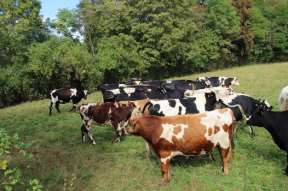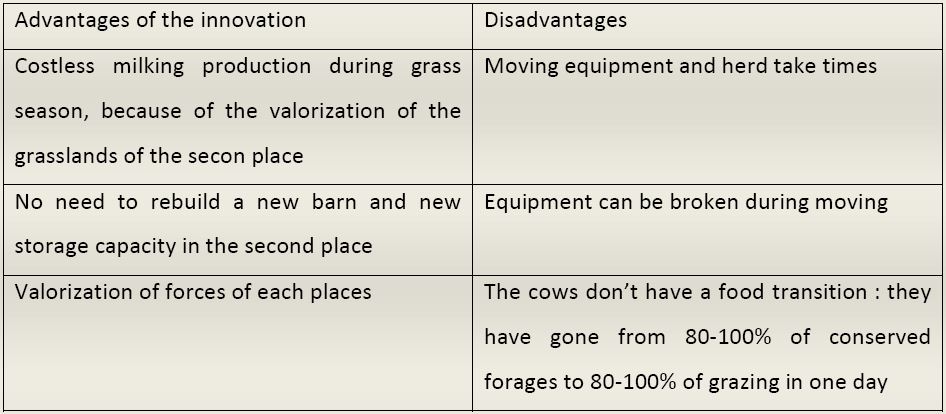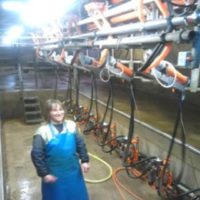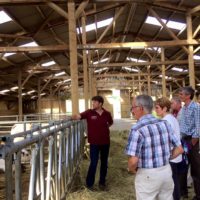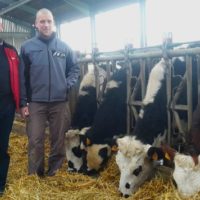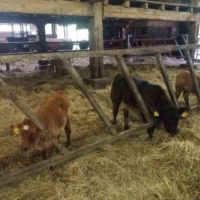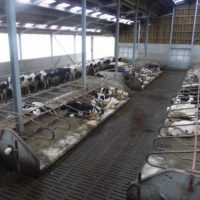Pasture 10 km from the wintering building with dairy cows
Farm: “GAEC d’Arazon”
Location: Vosges, France
Case study
 Pasture 10 km from the wintering building with dairy cows (.pdf)
Pasture 10 km from the wintering building with dairy cows (.pdf)
Description
Background
The GAEC d’Arazon is composed of two farms combined in 2007.
First farm:
- The building can house 80 dairy cows
- Enough of storage capacity for forage to feed the herd during winter
- 15 ha of grassland available for pasture
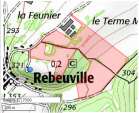
Second farm:
- The old building can house about 50 dairy cows
- Not enough of storage capacity for the whole herd
- 73 ha of grassland available for pasture
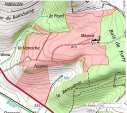
After the fusion of these two farms, only the first place building was big enough to house the whole herd. The two places are 10 km far.
Detailed description
The solution was to keep the big building of the first place for house the herd during winter and to move the herd in the second place during summer to have enough area for the pasture.
The milking management could be solved with 3 options:
- 2 fix milking parlour, one in each place
- 1 mobile milking parlour
- 2 places for milking but only one mobile equipment (pumps, pipes…)
The investment was almost the same between these 3 options.
The last option was chosen, because of the ease of cleaning a fixed installation relative to a mobile. The disadvantage of the first option was that the equipment would only be used for 6 months a year, which is bad for machine maintenance (seals …).
Results
Farmers are satisfied of the installation. Equipment is moved twice a year and the pasture area of the second place is enough productive to feed the herd during all the season.
Perspective and threats
The innovation is not challenged by the farmers and seems to be well adapted of the context. The future ways of progress of the farmers is to manage a cattle and sheep combined pasture to limit parasitism and to have a better grass valorization.
Another issue is the accentuation of the heat and drought in summer : that can disturb grazing and make necessary to feed animals during summer with conserved forage, which involve to build new storage capacities in the second place or to moving two more times the equipment and animals.
Farm description
- Sheep breeding3.8 annual work units
- Dairy cows and sheep combined
- 85 dairy cows and 65 ewes
- Organic agriculture
- Objective of productivity: 5000L /cows/year
- Three main soil types:
- Superficial clay and limestone, deep of about 10 to 40 cm before the limestone rock (130 ha).
- Deep clay soil (75 ha)
- Deep clay soil, relatively close to the river with floods every year (15ha)
Climate
Climate is continental, with cold winter and warm summer. Rain are quite homogenous during the year excepted July and august witch are more dry and with thunderstorm. As for other regions, climatic hazards are more and more frequent and impact grasslands productivity. 2016 was a very rainy years. This amount of rains has impacted the quality of forage: the mows had to be report of 3 weeks at least as usual. 2017 was marked by a cold spring and a reduction of grass growth compared
Additional information
| Farming system | organic farming |
|---|---|
| Domains of innovation | grazing management system, machinery, tools |
| Main types of animal | dairy cattle, meat sheep |
| Country | France |
| Product type | Case study |
| Language | English |

